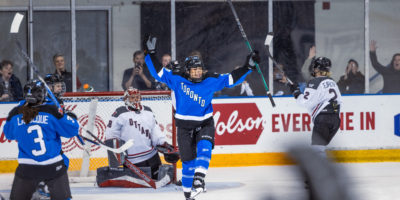By Bill Cowin
In recent years the sports world has not been dominated by words like “runs”, “goals” and “touchdowns” but rather “strikes”, “lockouts”, “free agency”, “salary arbitration” and—the catch phrases of the ‘90s—small and large market franchises.
In other words, the business side of sports has driven tradition and history of sports into oblivion.
In today’s world of sports the marketability of merchandise (hats, t-shirts, etc.) is more important than the success of a team or its history. Recently, the New York Islanders announced they were changing their orange, blue and white uniforms—the uniforms they wore when they won five consecutive Stanley Cups in the late ‘70s & early ‘80s—simply because they rank last among NHL teams in merchandise sales.
In Toronto the most appalling example of a team turning its back on its own history and traditions came just a few months ago here in Toronto.
Having dropped to the level of bottom feeder among pro sports teams in the city, the Toronto Argonauts Football Club’s new owners—the TSN/Labatt corporate web—decided they wanted their team to have a so-called fresh new look. When the dust settled there was nothing left of the club’s 121-year history.
Ever since day-one the team’s colors have been Cambridge and Oxford blue, earning the nickname the Double Blue. The Argos history includes 12 Grey Cup championships as the Double Blue.
All this has been thrown away in an attempt to attract younger fans. The team’s new colors are navy blue, silver and slate green and the new logo features a warrior holding a shield while facing an oncoming tide of water.
The club’s new uniforms even trample on the traditions of football. Football uniforms usually feature 12-inch numbers on the front and back, four-inch numbers on the sleeves and the team’s logo on the shoulders.
Sean Michael Edwards Design Inc. has tried to totally redesign football uniforms with its creations for the Argos and the Memphis Mad Dogs, a new expansion franchise for the CFL this season. SME has designed a uniform that has the team logo dominating the front of the jersey along with four-inch numbers at the top, while maintaining the 12-inch numbers on the back and more four-inch numbers on the sleeve.
The club has also turned its back on the history of its origins. The Argos were founded by the Toronto Argonaut Rowing Club in 1874. In a letter included with season’s ticket renewal packages, club president Bob Nicholson told subscribers of the new look that the team would have this year and that the club would be drawing on the story of Prince Jason and The Argonauts to complete the change. A more apt description that comes to mind is assassination of the club’s history.
As if all this wasn’t bad enough, the May issue of Toronto Life magazine claims the Toronto Blue Jays’ logo needs to be redesigned. The “This City” section of the magazine claims “The Toronto Blue Jay uniform—conceived by Savage Sloan in the dark age of 1976—manages, like an old Abba album, to claim its own piece of insipid turf. Nobody likes it, but nobody has plans to change it.”
Toronto Life got Vandenberg & Co. designers to redesign the Jays logo and uniform. What Vandenberg came up with doesn’t include the red Maple Leaf or the double line lettering of the current logo and uniform.
Are Toronto Life and Vandenberg suggesting that marketability is more important than national pride? And as for the lettering, it is one aspect of the Blue Jays’ logo and uniform that is unique from Major League Baseball’s 27 other teams.
It’s bad enough that business operations of the professional leagues are dominating headlines and pushing the games themselves to the back burner, now the business of fashion is doing the same. What does fashion have to do with sports?
I just wonder if, after debating whose uniforms look better, anyone will know who won the game.










Leave a Reply